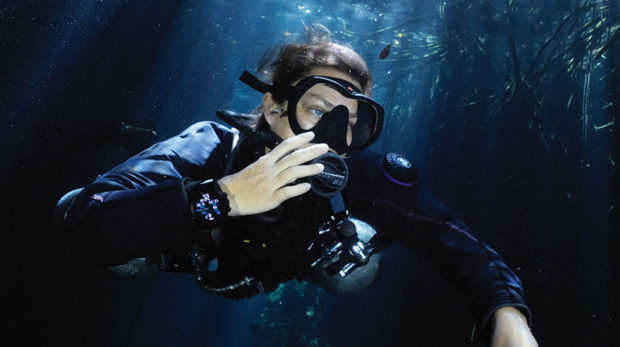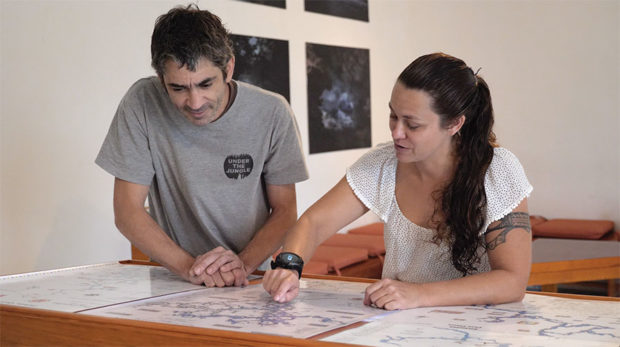Why Wet Rocks?
Cave divers don’t get more passionate or curious than DIVER’s newest subterranean columnist…
By Natalie Gibb

Most people have never considered diving underground into a flooded cave. It’s not an activity that shows up on their radar. The fact that I do this for a living makes meeting people at parties interesting:
Person: “Nice to meet you, Natalie, what do you do for a living?”
Natalie: “I’m a cave diver.”
Person: …
Natalie: “It’s not as bad as it sounds.”
Person: …
Cave diving gets a bit of a bad rap, which is unsurprising. I basically hike around in a steaming jungle, find little water-filled holes in the ground, put on my body’s weight in dive equipment, and go look at wet rocks. This doesn’t sound like most people’s idea of a good time. So, for the first of my columns for DIVER, I thought I would introduce my sport and passion in a different light, and try to convince readers that I am not completely bat-poop insane for doing what I do.
Cave diving has a reputation as the “world’s most dangerous sport”, a reputation that I disagree with. Perhaps at the birth of the sport cave divers had alarmingly low survival rates, but by analyzing cave fatalities to determine what behaviours put cave divers at risk, cave diving has become exponentially safer. The community has standardized practices that keep divers from dying: the use of a guideline to avoid getting lost, always reserving more than twice the breathing gas needed to exit the cave, carrying redundant pieces of all vital life support equipment, avoiding tight places unless properly trained, and so on. This isn’t an adrenaline sport, and most people can become safe cave divers with proper training. Driving to the dive site is usually the most dangerous part of cave diving.
But this still doesn’t answer the question: Why wet rocks? There is no simple answer. The reasons to cave dive are as diverse as cave divers themselves, but I can tell you why I love cave diving. Flooded caves are beautiful and ancient. In Mexico where I live, divers can swim through forests of the most delicate and unexpected stalactites: formations that were last growing 10-12,000 years ago. There is a sense of three dimensional space, and a freedom of movement through it, that I don’t feel in the ocean. In the cave, I am tucked into a secret part of the planet that few people get to see. And I am curious, always wondering where a cave passage leads and what is around the next corner. It never ceases to amaze me that tiny puddles in the jungle floor open into some of the largest and most awe inspiring places on the planet.

My primary reason for cave diving is enjoyment, I simply love it. However, cave diving is also a tool for scientific research. Survey of new underwater cave systems aids in understanding subterranean aquifers, which is important for water management and conservation. Cave divers have discovered human remains, artifacts, and ice-age animal remains, all of which are especially well-preserved in the in fresh, cool water of the caves. These findings provide clues to the mysteries of the past and human history. There are even creatures living in the caves! No, not monsters, but small animals such as blind fish and crustaceans, which are uniquely adapted to live in the darkness. A wide variety of microbial and bacterial growths also thrive in the difficult environment of the cave, and learning about the special adaptations and life cycles of these species will help scientists to understand more about the diversity of life on Earth. Flooded caves are very much on the unexplored frontier of science.
There’s also a practical reason to cave dive: cave diving improves dive skills. In my opinion, there is no more difficult dive environment on the planet than a flooded cave. The highest levels of control, finesse, and efficiency are required to cave dive well. Learning these skills and using them in the demanding environment of the cave will improve a diver’s techniques and can be applied to any type of diving.
There’s a whole other level of the planet just under our feet. It’s unexplored and it’s mysterious. Almost no one gets to see it, and I count myself fortunate to be able to visit this lower world regularly and to train others to do so safely. Cave divers are not insane, we are just a little curiouser than most.
Natalie Gibb Is a full cave instructor, explorer, and researcher based in Mexico’s Riviera Maya. She is a published author, international speaker, and cave conservationist. For more visit: www.underthejungle.com
Leave a Comment







